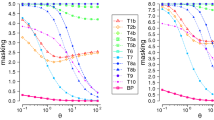Abstract
In this paper, we suggest a least squares procedure for the determination of the number of upper outliers in an exponential sample by minimizing sample mean squared error. Moreover, the method can reduce the masking or “swamping” effects. In addition, we have also found that the least squares procedure is easy and simple to compute than test procedure T k, suggested by Zhang (1998) for determining the number of upper outliers, since Zhang (1998) need to use the complicated null distribution of T k. Moreover, we give three practical examples and a simulated example to illustrate the procedures. Further, simulation studies are given to show the advantages of the proposed method. Finally, the proposed least squares procedure can also determine the number of upper outliers in other continuous univariate distributions (for example, Pareto, Gumbel, Weibull, etc.).
Similar content being viewed by others
References
Balasooriya, U. (1989), Detection of outliers in the exponential distribution based on prediction, Communications in Statistics, Series A, 18, 711–720.
Barnett, V. and Lewis, T. (1994), Outliers in Statistical Data, 3rd Edn (Chichester, Wiley).
Basu, A. P. (1965), On some tests of hypotheses relating to the exponential distribution when some outliers are present, Journal of the American Statistical Association, 60, 548–559.
Chikkagoudar, M. S. and Kunchur, S. H. (1983), Distributions of test statistics for multiple outliers in exponential samples, Communication in Statistics, Series A, 12, 2127–2142.
D’Agostino, R. B. and Stephens M. A. (1986), Goodness-of-fit Techniques, Marcel Dekker, Inc., New York.
Jeevanand, E. S. and Nair, N. U. (1993), Estimation of exponential parameters in the presence of outliers, Biometrical Journal, 35, 471–478.
Jeevanand, E. S. and Nair, N. U. (1994), Estimating P[X > Y] from exponential samples containing spurious observations, Communications in Statistics, Series A, 23, 2629–2642.
Jeevanand, E. S. and Nair, N. U. (1996), Bayes prediction interval for the exponential and Pareto population in the presence of an outliers, Far East Journal of Mathematical Sciences, Professor Bhattacharya Memorial Volume, Part I, 81–95.
Jeevanand, E. S. and Nair, N. U. (1998), On determining the number of outliers in exponential and Pareto samples, Statistical Papers, 39, 277–290.
Joshi, P. C. (1972), Efficient estimation of the mean of an exponential distribution when an outlier is present, Technometrics, 14, 137–143.
Joshi, P. C. (1988), Estimation and testing under exchangeable exponential model with a single outlier, Communication in Statistics, Series A, 17, 2315–2326.
Kale, B. K. (1976), Detection of outliers, Sankhya, Series B, 38, 356–363.
Kale, B. K. and Sinha, S. K. (1971), Estimation of expected life in the presence of an outlier observation, Technometrics, 13, 755–759.
Kale, V. B. and Kale, B. K. (1992), Outliers in exponential sample — a Bayesian approach, Gujarat Statistical Review, Professor Khatri Memorial Volume.
Kimber, A. C. and Stevens, H. J. (1981), The null distribution of a test for two upper outliers in an exponential sample, Applied Statistics, 30, 153–157.
Nelson, W. (1982), Applied life data analysis, John Wiley, New York, 104–111.
Pettit, L. I. (1988), Bayes method for outliers in exponential sample, Journal of the Royal Statistical Society, Series B, 50, 371–180.
Sinha, S. K. (1973), Life testing and reliability estimation for nonhomogeneous data — a Bayesian approach, Communication in Statistics, Series A, 2, 235–243.
Tse, Y. K. and Balasooriya, U. (1991), Test for multiple outliers in an exponential sample, Sankhya, Series B, 53, 56–63.
Veale, J. R. (1975), Improved estimation of expected life when one identified spurious observation may be present, Journal of the American Statistical Association, 70, 398–401.
Zhang, J. (1998), Tests for multiple upper or lower outliers in an exponential sample, Journal of Applied Statistics, 25, 245–255.
Author information
Authors and Affiliations
Corresponding author
Rights and permissions
About this article
Cite this article
Wu, JW. A note on determining the number of outliers in an exponential sample by least squares procedure. Statistical Papers 42, 489–503 (2001). https://doi.org/10.1007/s003620100075
Received:
Revised:
Issue Date:
DOI: https://doi.org/10.1007/s003620100075



